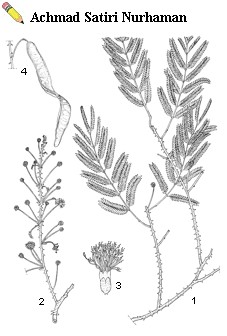Record Number
2324
PROSEA Handbook Number
12(3): Medicinal and poisonous plants 3
Taxon
Acacia concinna (Willd.) DC.
This article should be read together with the article on the genus: Acacia in the Handbook volume indicated above in this database.
This article should be read together with the article on the genus: Acacia in the Handbook volume indicated above in this database.
Protologue
Prodr. 2: 464 (1825).
Synonyms
Acacia rugata (Lamk) Buch.-Ham. ex Benth. (1842), Acacia sinuata (Lour.) Merr. (1935).
Vernacular Names
Soap pod tree (En). Indonesia: kate-kate kecil (Moluccas), gongai (Banda). Cambodia: bânla: sâ-'öt, ba:y dâmna:ëb. Laos: 'sôm2 po:y1. Thailand: som khon, som poi (northern). Vietnam: keo l[as] me.
Distribution
Acacia concinna is widely distributed in tropical Asia and occurs throughout South-East Asia.
Uses
In India and Thailand, a decoction of young leaves is taken for body pain, headache and fever. A decoction of the pods is said to relieve biliousness and acts as a purgative. The pods are in great demand in India as an Ayurvedic product for promoting hair growth and to remove dandruff; they are sold dried and as powder in the market. They have emetic, laxative and diuretic properties and are ingested to treat constipation and kidney and bladder affections. The seeds are used externally in Thailand and India to treat skin diseases. Acacia concinna is used as a hedge plant in Indonesia, whereas the tips of stems are occasionally eaten as a vegetable. In India, tender leaves are used in chutneys; they are acidic. The fruits are sometimes used in cooking in the Philippines. The dried pods are steeped in scented water for ablution during the Water Festival and New Year celebration in Thailand.
Observations
An erect, spreading or scrambling shrub or liana, up to 18(—30) m long; leaflets membranous, lateral veins of leaflets forming a reticulate pattern beneath, glands on petiole and rachis circular to elliptical; flower glomerules 7—12 mm in diameter; pod oblong, often with constrictions, 4.5—15 cm x 1.5—2 cm.Acacia concinna occurs in primary and secondary rain forests, often at riversides, also in forest margins and clearings, up to 1000 m altitude.
Image
 | Acacia concinna (Willd.) DC. - 1, branch with leaves; 2, flowering branch; 3, flower; 4, fruit |
Selected Sources
[247]Flora Malesiana (various editors), 1950—. Foundation Flora Malesiana. Rijksherbarium/Hortus Botanicus, Leiden, the Netherlands.
[249]Flora of Thailand (various editors), 1970—. The Forest Herbarium, Royal Forest Department, Bangkok, Thailand.
[250]Flore du Cambodge, du Laos et du Viêtnam [Flora of Cambodia, Laos and Vietnam] (various editors), 1960—. Muséum National d'Histoire Naturelle, Paris, France.
[263]Gafur, M.A., Obata, T., Kiuchi, F. & Tsuda, Y., 1997. Acacia concinna saponins. I. Structures of prosapogenols, concinnosides A—F, isolated from the alkaline hydrolysate of the highly polar saponin fraction. Chemical and Pharmaceutical Bulletin 45(4): 620—625.
[334]Heyne, K., 1950. De nuttige planten van Indonesië [The useful plants of Indonesia]. 3rd Edition. 2 volumes. W. van Hoeve, 's-Gravenhage, the Netherlands/Bandung, Indonesia. 1660 + CCXLI pp.
[760]Quisumbing, E., 1978. Medicinal plants of the Philippines. Katha Publishing Co., Quezon City, the Philippines. 1262 pp.
[778]Reddy, P.S.R., Rajasekhar, A. & Gopal, G.R., 1998. Vegetative propagation of Acacia concinna DC. by stem cuttings. The Indian Forester 124(3): 264—266.
[833]Sekine, T. et al., 1997. Structure and synthesis of a new monoterpenoidal carboxamide from the seeds of the Thai medicinal plant Acacia concinna. Chemical and Pharmaceutical Bulletin 45(1): 148—151.
[922]Tezuka, Y., Honda, K., Banskota, A.H., Thet, M.M. & Kodata, S., 2000. Kinmoonoside A—C, three new cytotoxic saponins from the fruits of Acacia concinna, a medicinal plant collected in Myanmar. Journal of Natural Products 63(12): 1658—1664.
[249]Flora of Thailand (various editors), 1970—. The Forest Herbarium, Royal Forest Department, Bangkok, Thailand.
[250]Flore du Cambodge, du Laos et du Viêtnam [Flora of Cambodia, Laos and Vietnam] (various editors), 1960—. Muséum National d'Histoire Naturelle, Paris, France.
[263]Gafur, M.A., Obata, T., Kiuchi, F. & Tsuda, Y., 1997. Acacia concinna saponins. I. Structures of prosapogenols, concinnosides A—F, isolated from the alkaline hydrolysate of the highly polar saponin fraction. Chemical and Pharmaceutical Bulletin 45(4): 620—625.
[334]Heyne, K., 1950. De nuttige planten van Indonesië [The useful plants of Indonesia]. 3rd Edition. 2 volumes. W. van Hoeve, 's-Gravenhage, the Netherlands/Bandung, Indonesia. 1660 + CCXLI pp.
[760]Quisumbing, E., 1978. Medicinal plants of the Philippines. Katha Publishing Co., Quezon City, the Philippines. 1262 pp.
[778]Reddy, P.S.R., Rajasekhar, A. & Gopal, G.R., 1998. Vegetative propagation of Acacia concinna DC. by stem cuttings. The Indian Forester 124(3): 264—266.
[833]Sekine, T. et al., 1997. Structure and synthesis of a new monoterpenoidal carboxamide from the seeds of the Thai medicinal plant Acacia concinna. Chemical and Pharmaceutical Bulletin 45(1): 148—151.
[922]Tezuka, Y., Honda, K., Banskota, A.H., Thet, M.M. & Kodata, S., 2000. Kinmoonoside A—C, three new cytotoxic saponins from the fruits of Acacia concinna, a medicinal plant collected in Myanmar. Journal of Natural Products 63(12): 1658—1664.
Author(s)
S. Aggarwal
Correct Citation of this Article
Aggarwal, S., 2003. Acacia concinna (Willd.) DC.. In: Lemmens, R.H.M.J. and Bunyapraphatsara, N. (Editors): Plant Resources of South-East Asia No 12(3): Medicinal and poisonous plants 3. PROSEA Foundation, Bogor, Indonesia. Database record: prota4u.org/prosea

All texts are licensed under a Creative Commons Attribution-Noncommercial-Share Alike 3.0 Netherlands License
This license does not include the illustrations (Maps,drawings,pictures); these remain all under copyright.